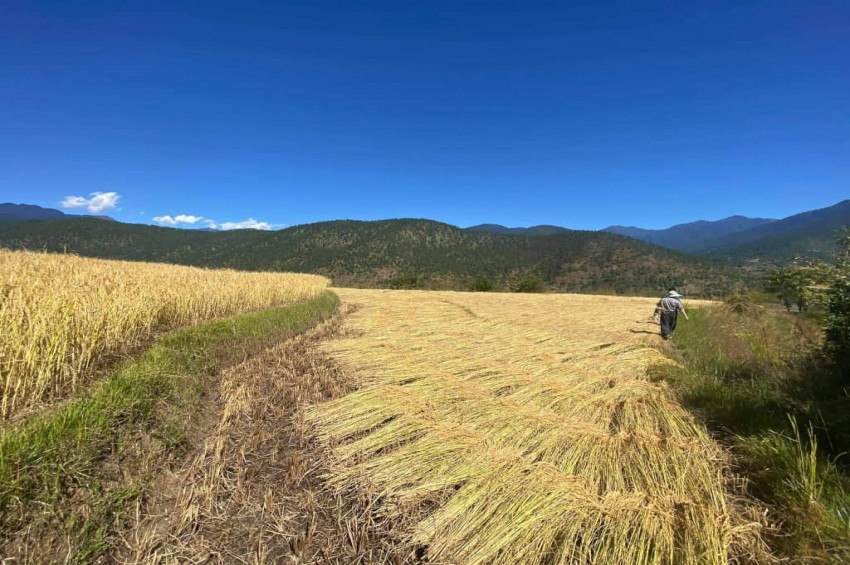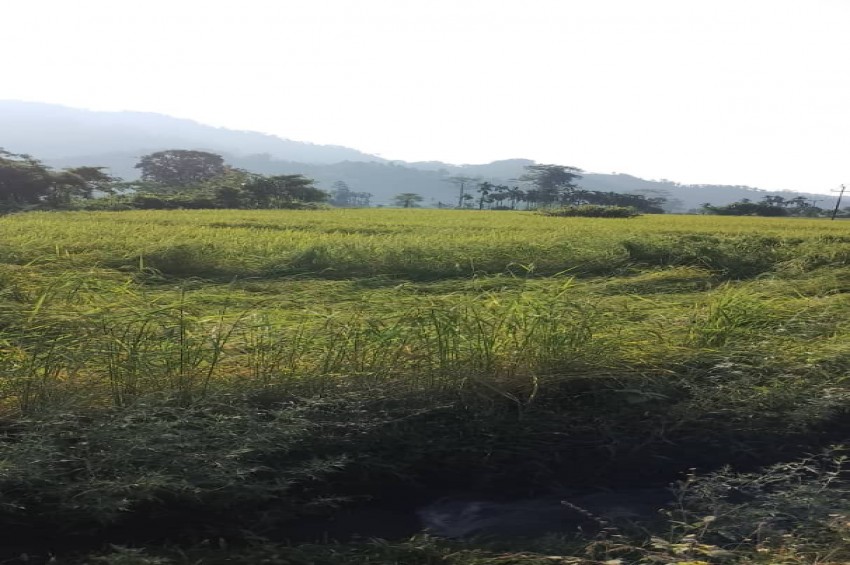Agricultural products have gained recognition for their organic and chemical-free production methods, which have made them popular among health-conscious consumers in the region
Bhutan has been gaining recognition for its high-quality agricultural products in recent years. Its unique geographical location and favorable climate have made it possible to produce a variety of fruits, vegetables, and other crops that are highly sought after by neighboring countries, such as India and Bangladesh.
Bhutanese agricultural products have gained recognition for their organic and chemical-free production methods, which have made them popular among health-conscious consumers in the region. Some of the most popular Bhutanese agricultural products include oranges, pineapples, apples, and cardamom.
The Druk brand, owned by Bhutan Agro Industries Limited (BAIL), has become a household name in India and Bangladesh. The brand is known for its high-quality food products, including juices, jams, pickles, and sauces. Druk products are exported to these countries, where they are highly valued for their taste and quality.
In addition to Druk products, Bhutanese fruits, vegetables, and spices are also highly sought after by traders in Kolkata and Dhaka. These traders are knowledgeable about Bhutanese agricultural products and often source them directly from Bhutanese farmers. Oranges, pineapples, and cardamom are among the most popular Bhutanese products in these markets.
However, in Delhi, the awareness of Bhutanese agricultural products seems to be relatively low, particularly among fruit and vegetable vendors. Commission agents in Delhi suggest that Bhutanese apples may face challenges in competing with Himachal apples due to the distance involved. This lack of awareness may be attributed to a need for more marketing efforts by Bhutanese farmers and exporters.
Despite this, the demand for Bhutanese agricultural products in India and Bangladesh is expected to continue growing in the coming years. The Bhutanese government has identified agriculture as a priority sector and has been taking steps to promote the sector, including providing subsidies and other incentives to farmers.
The quality of Bhutanese agricultural products is highly valued by wholesalers and consumers alike. Wholesalers prioritize freshness and proper grading of products, ensuring that customers receive consistent quality that meets their needs and preferences. Bhutanese products are often well-presented in supermarkets and retail markets, attracting customers with their organized and visually appealing displays.
Pricing is another important consideration for wholesalers and consumers. Retail and open markets often offer lower prices due to lower overhead costs, making them attractive to price-sensitive consumers. Wholesalers must offer competitive pricing while ensuring profitability through strategies such as negotiating with suppliers or buying in bulk.
Labeling plays a crucial role in providing essential information to consumers, such as the date of packing, weight, and price. This enables consumers to make informed decisions and determine the freshness and value of the products they purchase.
Branding and storytelling are effective tools in promoting Bhutanese semi-processed and organic agricultural products. By emphasizing organic production methods and sharing the unique story behind the products, brands can differentiate themselves and create stronger emotional connections with consumers.
Overall, Bhutan's high-quality agricultural products have made a mark in neighboring markets, with growing recognition and demand. Continued efforts in marketing, awareness, and maintaining product quality will further enhance the country's position as a reliable source of premium agricultural products.
Bhutan has recognized the export of agricultural products as a key marketing strategy and aims to target high-value-added agricultural products for discerning customers in neighboring countries. While there is anecdotal evidence suggesting market potential and demand for Bhutanese agricultural products in neighboring ASEAN countries like Singapore, Malaysia, and Thailand, no comprehensive studies or focused assessments have been conducted to validate these claims.
Information has been gathered through informal channels, desk research by government officials, and observations of higher prices in supermarkets during officials' visits abroad.
To address this knowledge gap, the RGoB has sought assistance from the Japan International Cooperation Agency (JICA) to conduct a thorough study on the selected ASEAN countries (Singapore, Thailand, Malaysia, and Japan), as well as India and Bangladesh in the SAARC region. The study focuses on evaluating the market potential for a range of agricultural commodities, including Potato (Seed Potato), Cereals, Ginger, Turmeric, Fruits, Lemongrass, Asparagus, and Nuts (Arecanut). A minimum of six commodities, including potato, will be targeted for the study.
The study has been divided into two phases. Phase one involved studying the Singapore, Thailand, Malaysia, and Japan markets for Bhutanese products, conducted by a foreign consultant based in Singapore. Phase two has been awarded to a local firm, the "Institute for Learning Solutions" in Thimphu, to undertake the marketing study of eight commodities in New Delhi, Kolkata, and Dhaka.
The study related to the markets in New Delhi, Kolkata, and Dhaka involves a comprehensive assessment of the supply chain, identification of potential agricultural products, and exploration of potential partner companies. This is achieved through market visits and engagements with relevant stakeholders in the listed SAARC countries. The study also examines the legal framework, laws, SROs (Statutory Regulatory Orders), and certification requirements for the identified potential products in the target markets.
The study incorporates economic analysis, including volume and value of imports, price analysis, and cost-returns analysis, to determine the market viability of Bhutanese products in Delhi, Kolkata, and Dhaka. Additionally, an economic analysis specifically focused on apples has been conducted to assess the feasibility of storing and distributing apples within the country.
The final chapter of the study will present the "Bhutanese RNR Product Exporting Plan." This plan will outline the potential crops and destination markets, along with the corresponding activities and schedule. It will also consolidate the findings from the study/survey conducted in Singapore, Malaysia, Thailand, and Japan.
India and Bangladesh are highlighted as two significant markets due to their large populations and substantial demand for food and agricultural products. India, with its diverse agro-climatic zones, offers opportunities for a wide range of crops, dairy products, and agricultural trade. Bangladesh, on the other hand, heavily relies on imports to meet its food and agricultural needs and has a significant demand for rice, vegetables, and fruits.
Both India and Bangladesh have implemented initiatives and policies to promote agricultural trade and investment. For instance, India has established a National Agricultural Market (NAM) to create a unified national market for agricultural commodities, while Bangladesh has set up export processing zones to facilitate exports and attract foreign investment.
The increasing demand for organic and natural products in India and Bangladesh presents a favorable opportunity for Bhutanese exporters specializing in these products. Bhutan's strong tradition of organic farming and production of high-quality, chemical-free agricultural products can cater to the preferences of consumers in these markets.
To succeed in these markets, Bhutanese exporters need to understand the regulatory and legal requirements of India and Bangladesh. They should also be aware of market dynamics, competition, and the preferences and needs of target consumers. Establishing relationships with potential buyers and distributors can play a vital role in navigating the market and establishing a foothold.
However, India and Bangladesh offer substantial opportunities for Bhutanese agricultural exports. With their large and growing populations, diverse food demands, and government initiatives to promote agricultural trade and investment, these markets hold great potential for Bhutanese agricultural products. However, exporters need to be well-informed about the regulatory requirements and market dynamics to succeed in these markets.
Bhutan has been gaining recognition for its high-quality agricultural products in recent years. Its unique geographical location and favorable climate have made it possible to produce a variety of fruits, vegetables, and other crops that are highly sought after by neighboring countries, such as India and Bangladesh.
Bhutanese agricultural products have gained recognition for their organic and chemical-free production methods, which have made them popular among health-conscious consumers in the region. Some of the most popular Bhutanese agricultural products include oranges, pineapples, apples, and cardamom.
The Druk brand, owned by Bhutan Agro Industries Limited (BAIL), has become a household name in India and Bangladesh. The brand is known for its high-quality food products, including juices, jams, pickles, and sauces. Druk products are exported to these countries, where they are highly valued for their taste and quality.
In addition to Druk products, Bhutanese fruits, vegetables, and spices are also highly sought after by traders in Kolkata and Dhaka. These traders are knowledgeable about Bhutanese agricultural products and often source them directly from Bhutanese farmers. Oranges, pineapples, and cardamom are among the most popular Bhutanese products in these markets.
However, in Delhi, the awareness of Bhutanese agricultural products seems to be relatively low, particularly among fruit and vegetable vendors. Commission agents in Delhi suggest that Bhutanese apples may face challenges in competing with Himachal apples due to the distance involved. This lack of awareness may be attributed to a need for more marketing efforts by Bhutanese farmers and exporters.
Despite this, the demand for Bhutanese agricultural products in India and Bangladesh is expected to continue growing in the coming years. The Bhutanese government has identified agriculture as a priority sector and has been taking steps to promote the sector, including providing subsidies and other incentives to farmers.
The quality of Bhutanese agricultural products is highly valued by wholesalers and consumers alike. Wholesalers prioritize freshness and proper grading of products, ensuring that customers receive consistent quality that meets their needs and preferences. Bhutanese products are often well-presented in supermarkets and retail markets, attracting customers with their organized and visually appealing displays.
Pricing is another important consideration for wholesalers and consumers. Retail and open markets often offer lower prices due to lower overhead costs, making them attractive to price-sensitive consumers. Wholesalers must offer competitive pricing while ensuring profitability through strategies such as negotiating with suppliers or buying in bulk.
Labeling plays a crucial role in providing essential information to consumers, such as the date of packing, weight, and price. This enables consumers to make informed decisions and determine the freshness and value of the products they purchase.
Branding and storytelling are effective tools in promoting Bhutanese semi-processed and organic agricultural products. By emphasizing organic production methods and sharing the unique story behind the products, brands can differentiate themselves and create stronger emotional connections with consumers.
Overall, Bhutan's high-quality agricultural products have made a mark in neighboring markets, with growing recognition and demand. Continued efforts in marketing, awareness, and maintaining product quality will further enhance the country's position as a reliable source of premium agricultural products.
Bhutan has recognized the export of agricultural products as a key marketing strategy and aims to target high-value-added agricultural products for discerning customers in neighboring countries. While there is anecdotal evidence suggesting market potential and demand for Bhutanese agricultural products in neighboring ASEAN countries like Singapore, Malaysia, and Thailand, no comprehensive studies or focused assessments have been conducted to validate these claims.
Information has been gathered through informal channels, desk research by government officials, and observations of higher prices in supermarkets during officials' visits abroad.
To address this knowledge gap, the RGoB has sought assistance from the Japan International Cooperation Agency (JICA) to conduct a thorough study on the selected ASEAN countries (Singapore, Thailand, Malaysia, and Japan), as well as India and Bangladesh in the SAARC region. The study focuses on evaluating the market potential for a range of agricultural commodities, including Potato (Seed Potato), Cereals, Ginger, Turmeric, Fruits, Lemongrass, Asparagus, and Nuts (Arecanut). A minimum of six commodities, including potato, will be targeted for the study.
The study has been divided into two phases. Phase one involved studying the Singapore, Thailand, Malaysia, and Japan markets for Bhutanese products, conducted by a foreign consultant based in Singapore. Phase two has been awarded to a local firm, the "Institute for Learning Solutions" in Thimphu, to undertake the marketing study of eight commodities in New Delhi, Kolkata, and Dhaka.
The study related to the markets in New Delhi, Kolkata, and Dhaka involves a comprehensive assessment of the supply chain, identification of potential agricultural products, and exploration of potential partner companies. This is achieved through market visits and engagements with relevant stakeholders in the listed SAARC countries. The study also examines the legal framework, laws, SROs (Statutory Regulatory Orders), and certification requirements for the identified potential products in the target markets.
The study incorporates economic analysis, including volume and value of imports, price analysis, and cost-returns analysis, to determine the market viability of Bhutanese products in Delhi, Kolkata, and Dhaka. Additionally, an economic analysis specifically focused on apples has been conducted to assess the feasibility of storing and distributing apples within the country.
The final chapter of the study will present the "Bhutanese RNR Product Exporting Plan." This plan will outline the potential crops and destination markets, along with the corresponding activities and schedule. It will also consolidate the findings from the study/survey conducted in Singapore, Malaysia, Thailand, and Japan.
India and Bangladesh are highlighted as two significant markets due to their large populations and substantial demand for food and agricultural products. India, with its diverse agro-climatic zones, offers opportunities for a wide range of crops, dairy products, and agricultural trade. Bangladesh, on the other hand, heavily relies on imports to meet its food and agricultural needs and has a significant demand for rice, vegetables, and fruits.
Both India and Bangladesh have implemented initiatives and policies to promote agricultural trade and investment. For instance, India has established a National Agricultural Market (NAM) to create a unified national market for agricultural commodities, while Bangladesh has set up export processing zones to facilitate exports and attract foreign investment.
The increasing demand for organic and natural products in India and Bangladesh presents a favorable opportunity for Bhutanese exporters specializing in these products. Bhutan's strong tradition of organic farming and production of high-quality, chemical-free agricultural products can cater to the preferences of consumers in these markets.
To succeed in these markets, Bhutanese exporters need to understand the regulatory and legal requirements of India and Bangladesh. They should also be aware of market dynamics, competition, and the preferences and needs of target consumers. Establishing relationships with potential buyers and distributors can play a vital role in navigating the market and establishing a foothold.
However, India and Bangladesh offer substantial opportunities for Bhutanese agricultural exports. With their large and growing populations, diverse food demands, and government initiatives to promote agricultural trade and investment, these markets hold great potential for Bhutanese agricultural products. However, exporters need to be well-informed about the regulatory requirements and market dynamics to succeed in these markets.













